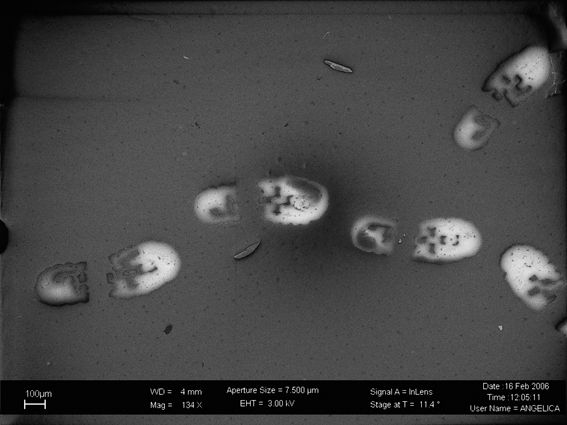
"One of the most influential artists in the world of Art & Nanotechnology"
Technarte
Nanoart | Seeing the invisible
'Nanoart removes the direct view of the image, and cancels the acquired superiority of sight. This is both a paradox and a provocation, as there has been in every revolutionary artistic movement.' Stefano Raimondi
'In an age of artistic grandeur, perhaps there is a need for a healthy and decisive downsizing. Nanoart is an art that makes itself down to the point where it makes itself invisible to the human eye.' Alessandro Scali
'One of the most influential artists in the world of Nanotechnology and Art'. Technarte
Origins
My research in the field of Nanoart began in 2006, in collaboration with the Polytechnic University of Turin. Since then, I’ve worked with materials and technologies invisible to the naked eye, creating micro- and nanoscale artworks. In this context, art is not representation, but an intervention into a dimension that exists — even if we cannot see it.
Scientific collaboration
Working closely with Professor Fabrizio Pirri’s team allowed me to engage with the precision and rigor of scientific research. Each project emerges from a dialogue between experimental method and artistic thought. The resulting works do not imitate science — they move through it.
Reversing the gaze
Projects like Actual size and Beyond the pillars of Hercules are visual and conceptual metaphors. They explore themes such as the limits of perception, the fragility of knowledge, and the relativization of the human point of view. For me, Nanoart is also this: an attempt to invert the hierarchy between the visible and the invisible.
A counterintuitive practice
In an art world dominated by spectacle, Nanoart chooses invisibility. It’s a form of silent resistance — an invitation to reconsider what it means to “see,” and where the meaning of a work truly resides. It activates imagination before vision.

MoonArk | A Cosmic Canvas for Nanoart
A space frame for Nanoart
In 2014, I was invited to contribute to the MoonArk project, an initiative led by Carnegie Mellon University aiming to send a permanent cultural artifact to the Moon — a capsule the size of a soda can, containing artworks and traces of human creativity. A symbolic and radical gesture, connecting the microscopic scale of nanoart with the vastness of space.
Two works for the Moon
My contribution included two nanometric artworks, C’moon and Man with Smartphone, created using focused ion beam (FIB) lithography. Housed within the MoonArk, these works inhabit the space between prehistory and the future, between body and machine. They are condensed, symbolic images — designed to travel beyond Earth, but also to question how we inhabit it.
C'moon
Located in the Moon Chamber, it draws inspiration from prehistoric petroglyphs. An archetypal imprint, an echo of the first human marks. It represents artistic gesture as a universal and primal act — a way of inscribing meaning into space.
Man with Smartphone
Placed in the Metasphere Chamber, it reflects on our dependence on digital devices. A small, connected, isolated, hybrid human figure. A critical and ironic image of our time: the Socialithic age, where contact has turned into connection.
Human scale, cosmic scale
These works were made possible through collaboration with the Center for Space Human Robotics at the Istituto Italiano di Tecnologia. A project born from the intersection of art, science, and robotics — a true experiment in dissolving disciplinary boundaries.
Future aspirations and impact
MoonArk marked a turning point in my artistic journey. Not only for merging the micro and the macro, but for placing the human perspective into context. Art — even in its smallest forms — can reach space. And gently remind us how infinitely small we really are.
Although the Peregrine 1 mission in January 2024 did not reach the lunar surface due to a technical failure, the meaning of the MoonArk project remains intact. Its interrupted journey does not diminish its value — it amplifies it. And the possibility of a future launch is still alive.

NANOART EXHIBITIONS
SOLO
Nanoart. Seeing the invisible | BergamoScienza – Bergamo, Palazzo Frizzoni | 2-21 october 2007
Nanoart. Seeing the invisible | Politecnico di Torino | 16 – 19 april 2008
Nanoart. Seeing the invisible | Art’co – first Como Art Fair | 16 – 19 may 2008
Nanoart. Seeing the invisible | Infini.To – Parco dell’astronomia di Torino | 23 may – 15 june 2008
GROUP
Technarte Exhibition | LACDA, Los Angeles, 12 december 2015 - 02 january 2016.
Principia. Stanze e sostanze delle arti prossime | Piazza del Duomo, Milan, april 2011.
Spaceship Turin | MIAAO – Museo di Arti Applicate, Torino / 6 october 2007 - 6 january 2008.
Youniverse | BIACS 3, Biennale of contemporary art of Sevilla / 2 october 2008 - 11 january 2009.
CONFERENCES
Technarte 2015, Los Angeles | Invited speaker. Title of the presentation: 'Nanoart: beyond visual arts, towards the Moon'.
Technarte 2013, Bilbao | Invited speaker. Title of the presentation: 'Biomusic'.
Comunicare Fisica 2012, Turin | Invited speaker. Title of the presentation: 'Art & physics'
Technarte 2010, Bilbao | Invited speaker. Title of the presentation: 'This is not an artwork' | 15 -17 april 2010.
Universos Y metaversos, artistic applications of new media | Invited speaker at University of Barcelona, 7 april 2010.
Nanoart: beyond the pillars of Hercules | Invited speaker at Technarte - Art & Science international conference, Bilbao | 23 –24 april 2009.
Nanoarte: between art, science and perception | Invited speaker at Infini.To – Parco dell’astronomia di Torino | 7 june 2008
Future of mind or mind the future? | Invited speaker at Accademia delle Scienze, Torino | 28 may 2008.
















